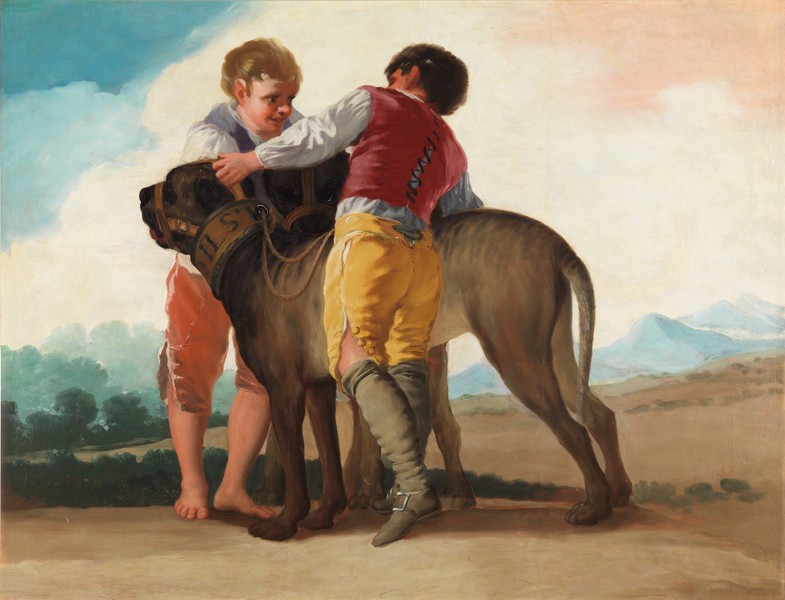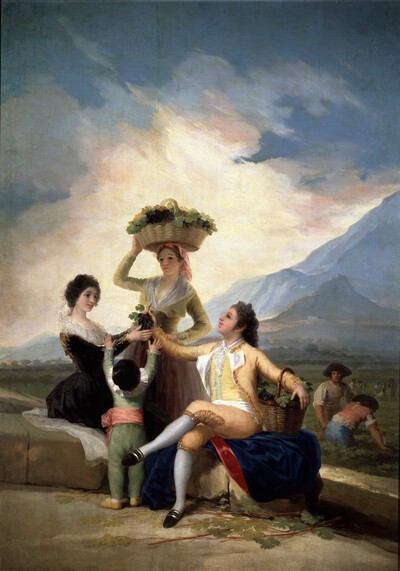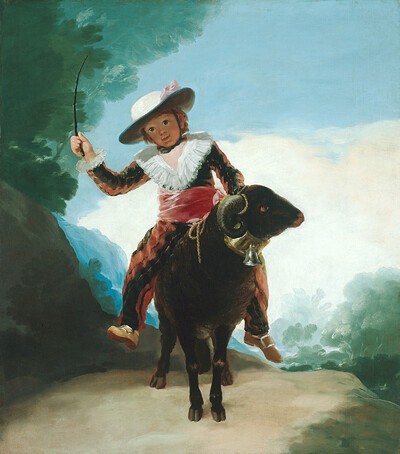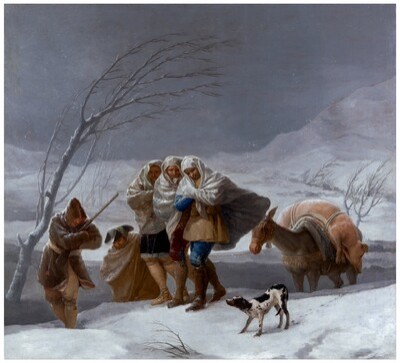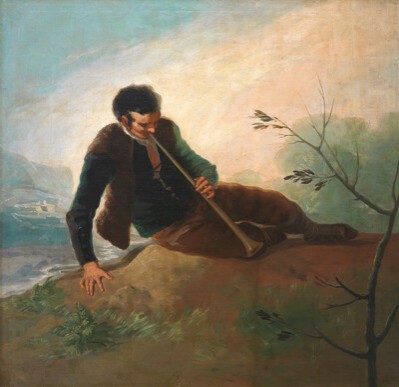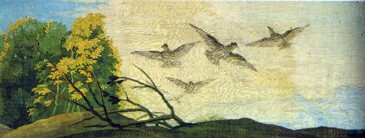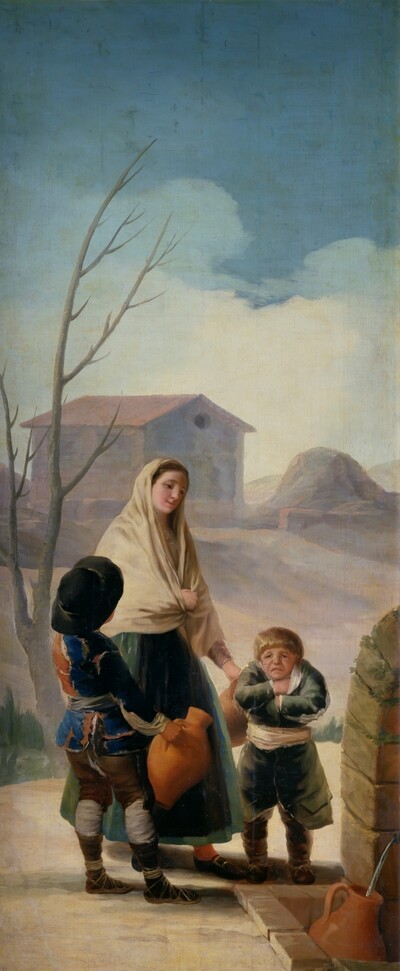- Cronología
- 1788
- Ubicación
- The Prado National Museum. Madrid, Madrid, Spain
- Dimensiones
- 112 x 145 cm
- Técnica y soporte
- Oil on canvas
- Reconocimiento de la autoría de Goya
- Documented work
- Titular
- El Prado National Museum
- Ficha: realización/revisión
- 15 Dec 2009 / 14 Jun 2023
- Inventario
- (P02524)
- Otros títulos:
-
Boys with Mastiffs (Niños con mastines)
Two Boys with Two Dogs (Dos niños con dos perros)
Two Boys Playing with Large Dog (Dos niños jugando con un perro grande)
See The Flower Girls.
This card was supposed to be one of the over-doors from the series of The Four Seasons, intended for the conversation or dining room in the palace at El Pardo. However, according to José Luis Sancho, it is more likely that it was part of the series of Country Scenes in the bedroom of the Infantas in the same palace. In this case, the tapestry would have hung on the south wall.
It was included in the inventory carried out by Vicente López in 1834 for Ferdinand VII's will, when it was attributed to José del Castillo.
Around 1856 or 1857, the cartoon was moved from the Royal Tapestry Factory of Santa Bárbara to the Palacio de Oriente in Madrid, and it remained in the tapestry basements until, under orders given on 18 January and 9 February 1870, it was taken to the Prado Museum that same year. For the next sixty years the work was still attributed to José del Castillo, until Valentín de Sambricio documented Goya's authorship.
Two fashionably-dressed boys stand next to two hunting dogs. The animals wear muzzles and are on leads. They have stopped so as to allow the boys to stroke them. In the background, a landscape featuring a far-off mountain range and a copse of trees is cut off by the figures, who appear to be of monumental size owing to the low viewpoint employed by Goya, without a doubt considering the elevated position of the tapestry over the door.
Going by its dimensions and tonal range, it has been assumed that this work would have flanked the main tapestry of The Flower Girls, next to the overdoor piece Boy on a Ram. However, the connection between this piece and the theme of springtime represented in The Flower Girls is not immediately obvious. Tomlinson, who also adds to the theme of the seasons that of the ages of man by comparing these works with a print by Remondini, believes that the boys represented here would have symbolized the age of twenty, although they appear considerably younger than that. A connection with spring and the signs of the zodiac can be found, however, in the same way as in Boy on a Ram, by interpreting the two boys and the two dogs as a highly original representation of Gemini, at the end of the season of spring.
The cartoon has received a number of different names in the various inventories. The main problem has been the correct identification of the dogs. At first, there only appeared to one, a mastiff. But the animals are wearing muzzles, identifying them as hunting dogs and not mastiffs, which would have been used to watch over cattle. As such, here we have opted to use as the main title that which takes this observation into consideration.
José Galiay refers to a sketch of this work in a speech given at the Academia de San Luis de José Sinués, and claims that it was exhibited in the show that coincided with the two-hundredth anniversary of Goya's birth. The current whereabouts of said sketch are unknown.
-
Goya y los artistas del su tiempoMuseo de ZaragozaZaragoza1946bicentenary of Goya’s birth, organized by the Real Academia de Nobles y Bellas Artes de San Luis. From May 16th to 23th 1946
-
GoyaPalacio de PedralbesBarcelona1977from April 12th to June 30th 1977cat. 11
-
Pintura mexicana y pintura española de los siglos XVI al XVIIIMéxicoMexico D.F.1991
-
Goya. 250 AniversarioMuseo Nacional del PradoMadrid1996consultant editor Juan J. Luna. From March 29th to June 2nd 1996cat. 43
-
Goya en Madrid. Cartones para tapices 1775-1794Museo Nacional del PradoMadrid2014p. 214
-
Zaragoza2017cat. 19
-
Tapices de GoyaMadridPatrimonio Nacional1946pp. 141, 150, 258, cat. 47 y láms. 163-1
-
Vie et ouvre de Francisco de GoyaParísOffice du livre1970pp. 79, 97, cat. 269
-
BarcelonaPolígrafa1970vol. I, pp. 269-270, cat. 227
-
L’opera pittorica completa di GoyaMilanRizzoli1974p. 102, cat. 207
-
Francisco de Goya, 4 vols.ZaragozaCaja de Ahorros de Zaragoza, Aragón y Rioja1980-1982vol. II, p. 43
-
Francisco de Goya, cartones y tapicescol. col. "Espasa Arte"Espasa Calpe1987pp. 147, 296, cat. 51C y p. 147 (il.)
-
Francisco de Goya. Los cartones para tapices y los comienzos de su carrera en la corte de Madridcol. col. "Ensayos de Arte Cátedra"MadridCátedra1987pp. 222-225 y p. 221 (il.)
-
Goya. 250 AniversarioMadridMuseo del Prado1996p. 323, cat. 43 y p. 122 (il.)
-
Salas del Palacio Real de El Pardo para las que se tejieron tapices sobre cartones de Francisco de Goya: identificación de las habitaciones y ajuste de las obras de Goya en los alzados de las paredesin HERRERO CARRETERO, Concha (curator, Tapices y cartones de Goya (catalogue of the exhibition organizated at the Palacio Real de Madrid, from may to june 1996)MadridPatrimonio Nacional, Goya 96, Lunwerg1996p. 165 (il.)
-
Goya en Madrid. Cartones para tapices 1775-1794MadridMuseo Nacional del Prado2014p. 214
-
BilbaoFundación bancaria “la Caixa” y Museo Nacional del Prado2018p. 72
